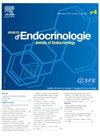46、XY低雄性化与NR5A1变异:单中心印度经验与系统回顾
IF 2.9
3区 医学
Q3 ENDOCRINOLOGY & METABOLISM
引用次数: 0
摘要
目的:enr5a1变异是导致46,xy DSD的罕见原因,来自印度的文献很少。缺乏对基因型-表型相关性的系统综述。我们的目的是描述临床,生化,组织学和基因型表型与46,xy DSD与NR5A1变异的相关性。方法对11例基因证实先证者进行回顾性单中心评价,并对288例文献进行系统评价。结果来自我们中心的46,XY DSD的NR5A1变异的6个先证表现出表型变异,女性到男性的社会性别变化约三分之二(4/7),原发性肾上腺功能不全(PAI) 1,以及5个新变异。系统评价纳入先证者299名(年龄:4.0[0.3-13]岁;Sinnecker评分:4[3-4]),共有218种不同的NR5A1变异。系统回顾报告了先证者中男女性别变化(27/166,16.3%)、自发性青春期/青春期男性化(37/86,43%)、兄弟姐妹中DSD(25/299, 8.3%)、父亲尿道下裂(7/299,2.3%)、母亲卵巢早泄(19/299,6.4%)、双侧阴唇性腺(71/214,33.2%)、缺失缪勒氏结构(187/232,80.6%)、PAI(5/222, 2.2%)和性腺恶性肿瘤(2/111,1.8%)。在青春期前期、青春期前期和青春期前后,分别有35.4%(17/48)、46.2%(18/39)和63.6%(49/77)的患者血清LH升高。生殖细胞在微青春期存在55.6%(5/9),在后期缺失96.8%(61/63)。在青春期前期和后期,支持细胞正常的比例分别为100%(7/7)和70.4%(38/54)。存在Mullerian结构和Sinnecker评分为4/5与LBD变异相关(54.5%vs. 5)。30.6% (P = 0.003)和7.3% (P = 0.004)的蛋白质开始丢失/缺失。结论NR5A1变异的XY DSD具有支持细胞和间质细胞功能的进行性下降,青春期男性化,部分性腺发育不良,性腺恶性肿瘤的风险可能低于其他来源的性腺发育不良。需要进一步的研究来证实这些观察结果。本文章由计算机程序翻译,如有差异,请以英文原文为准。
46, XY under-virilization and NR5A1 variants: Monocentric Indian experience and systematic review
Purpose
NR5A1 variants are rare causes of 46,XY DSD with scarce literature from India. A systematic review of genotype–phenotype correlation is lacking. We aim to describe clinical, biochemical, histological, and genotype–phenotype correlation in 46,XY DSD with NR5A1 variants.
Methods
Retrospective monocentric review of 11 genetically-proven probands and systematic review including these and 288 from the literature.
Results
Eleven probands of 46,XY DSD with NR5A1 variants from our centre exhibited phenotypic variability, female-to-male social-gender change in ∼two-thirds (4/7), primary adrenal insufficiency (PAI) in one, and five novel variants. Systematic review included 299 probands (age: 4.0 [0.3–13] years; Sinnecker score: 4 [3–4]) with 218 different NR5A1 variants. Systematic review reported female-to-male gender-change (27/166, 16.3%), spontaneous puberty/pubertal virilization (37/86, 43%), DSD in siblings (25/299, 8.3%), paternal hypospadias (7/299, 2.3%), maternal premature ovarian insufficiency (19/299, 6.4%), bilateral labio-scrotal gonads (71/214, 33.2%), absent Mullerian structure (187/232, 80.6%), PAI (5/222, 2.2%) and gonadal malignancy (2/111, 1.8%) in probands. Serum LH was elevated in mini-puberty, pre-puberty, and peri/post-puberty in 35.4% (17/48), 46.2% (18/39), and 63.6% (49/77) patients, respectively. Germ cells were present in 55.6% (5/9) in mini-pubertal age and absent in 96.8% (61/63) at later age. Sertoli cells were reported normal in 100% (7/7), and 70.4% (38/54) in mini-pubertal and later ages, respectively. Presence of Mullerian structures and Sinnecker score of 4/5 were associated with LBD variants (54.5%vs. 30.6%, P = 0.003) and protein start-lost/deletion (7.3% vs. nil, P = 0.004), respectively.
Conclusions
46,XY DSD with NR5A1 variants is characterized by progressive decline in Sertoli and Leydig cell function, pubertal virilization, frequent partial gonadal dysgenesis and probably lower gonadal malignancy risk than gonadal dysgenesis of other origin. Further studies are warranted to validate these observations.
求助全文
通过发布文献求助,成功后即可免费获取论文全文。
去求助
来源期刊

Annales d'endocrinologie
医学-内分泌学与代谢
CiteScore
4.40
自引率
6.50%
发文量
311
审稿时长
50 days
期刊介绍:
The Annales d''Endocrinologie, mouthpiece of the French Society of Endocrinology (SFE), publishes reviews, articles and case reports coming from clinical, therapeutic and fundamental research in endocrinology and metabolic diseases. Every year, it carries a position paper by a work-group of French-language endocrinologists, on an endocrine pathology chosen by the Society''s Scientific Committee. The journal is also the organ of the Society''s annual Congress, publishing a summary of the symposia, presentations and posters. "Les Must de l''Endocrinologie" is a special booklet brought out for the Congress, with summary articles that are always very well received. And finally, we publish the high-level instructional courses delivered during the Henri-Pierre Klotz International Endocrinology Days. The Annales is a window on the world, keeping alert clinicians up to date on what is going on in diagnosis and treatment in all the areas of our specialty.
 求助内容:
求助内容: 应助结果提醒方式:
应助结果提醒方式:


